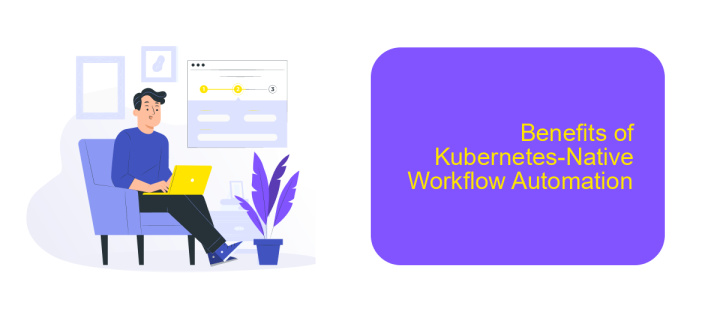Kubernetes-native Workflow Automation
Kubernetes-native workflow automation revolutionizes how applications are deployed and managed in cloud environments. By leveraging Kubernetes' robust orchestration capabilities, this approach streamlines complex workflows, enhances scalability, and ensures high availability. Ideal for DevOps teams, it integrates seamlessly with existing CI/CD pipelines, enabling rapid, reliable, and repeatable deployment processes. Discover how Kubernetes-native automation can transform your operational efficiency and agility.
Introduction
Kubernetes-native workflow automation is revolutionizing the way organizations manage and automate their cloud-native applications. By leveraging Kubernetes, teams can streamline their workflows, improve scalability, and ensure high availability of their services. This approach allows for seamless integration with existing Kubernetes clusters, making it easier to deploy, manage, and scale applications without the need for extensive manual intervention.
- Improved scalability and resource management
- Seamless integration with Kubernetes clusters
- Enhanced reliability and availability
- Reduced manual intervention and operational overhead
One of the key advantages of Kubernetes-native workflow automation is its ability to integrate with various services and tools. For instance, ApiX-Drive provides a robust platform for setting up and managing integrations with other services, enhancing the overall efficiency of your workflows. By automating repetitive tasks and enabling smooth data flow between applications, Kubernetes-native workflow automation empowers organizations to focus on innovation and growth.
Workflow Architectures in Kubernetes

Workflow architectures in Kubernetes offer a flexible and scalable approach to automating complex processes. By leveraging Kubernetes' native capabilities, workflows can be orchestrated using containers, ensuring that each task within the workflow is isolated and easily manageable. This architecture allows for the dynamic scaling of tasks, efficient resource utilization, and seamless integration with other Kubernetes-native tools and services. Moreover, the declarative nature of Kubernetes manifests facilitates the definition and management of workflows, making it easier to maintain and update them over time.
Integrating external services into Kubernetes workflows can further enhance their capabilities. For instance, using a service like ApiX-Drive can simplify the process of connecting various applications and automating data transfer between them. ApiX-Drive provides a user-friendly interface for setting up integrations without the need for extensive coding, allowing teams to focus on the core aspects of their workflows. By incorporating such services, Kubernetes-native workflows can achieve higher levels of automation and efficiency, ultimately driving better outcomes for businesses.
Kubernetes-Native Workflow Tools

Kubernetes-native workflow tools are designed to automate and streamline processes within Kubernetes environments. These tools offer seamless integration, scalability, and resilience, making them essential for modern cloud-native applications.
- Argo Workflows: A container-native workflow engine for orchestrating parallel jobs on Kubernetes.
- Tekton: An open-source framework for creating CI/CD systems, allowing developers to build, test, and deploy across cloud providers.
- Kubeflow Pipelines: A platform for building and deploying scalable machine learning workflows.
- ApiX-Drive: A service that facilitates the integration of various applications and services, simplifying workflow automation within Kubernetes clusters.
- Airflow on Kubernetes: A platform to programmatically author, schedule, and monitor workflows, fully integrated with Kubernetes.
These tools enhance the efficiency of development and operational workflows, enabling teams to focus on innovation rather than infrastructure management. By leveraging Kubernetes-native workflow tools, organizations can achieve higher productivity, reduced operational overhead, and improved application reliability.
Benefits of Kubernetes-Native Workflow Automation

Kubernetes-native workflow automation offers numerous advantages for modern DevOps practices. By leveraging the native capabilities of Kubernetes, teams can achieve greater efficiency and scalability in managing their workflows.
One of the primary benefits is the seamless integration with containerized applications. This ensures that workflows are consistent and can be easily replicated across different environments. Moreover, using Kubernetes-native tools allows for better resource management and reduces the overhead associated with traditional workflow automation solutions.
- Enhanced scalability and flexibility
- Improved resource utilization
- Seamless integration with containerized environments
- Consistent and replicable workflows
Additionally, integrating with services like ApiX-Drive can further streamline the automation process. ApiX-Drive simplifies the setup of integrations, allowing teams to connect various applications and services effortlessly. This enhances the overall efficiency of Kubernetes-native workflow automation, making it easier to manage complex workflows with minimal manual intervention.
Conclusion
In conclusion, Kubernetes-native workflow automation presents a transformative approach to managing complex deployments and orchestrations in cloud-native environments. By leveraging the inherent scalability, resilience, and flexibility of Kubernetes, organizations can streamline their development pipelines, reduce operational overhead, and improve the reliability of their services. This paradigm shift not only enhances productivity but also fosters innovation by allowing teams to focus more on creative problem-solving rather than mundane operational tasks.
Moreover, integrating automation tools like ApiX-Drive into Kubernetes workflows can further enhance efficiency. ApiX-Drive simplifies the process of connecting various services and automating data transfer between them, making it easier for teams to manage integrations without extensive coding knowledge. This synergy between Kubernetes-native automation and integration platforms empowers organizations to build more robust, scalable, and efficient workflows, ultimately driving business growth and technological advancement.
FAQ
What is Kubernetes-native workflow automation?
How can I automate workflows in a Kubernetes environment?
What are the benefits of Kubernetes-native workflow automation?
Can I integrate third-party services into my Kubernetes workflows?
Is it necessary to have advanced Kubernetes knowledge to implement workflow automation?
Time is the most valuable resource in today's business realities. By eliminating the routine from work processes, you will get more opportunities to implement the most daring plans and ideas. Choose – you can continue to waste time, money and nerves on inefficient solutions, or you can use ApiX-Drive, automating work processes and achieving results with minimal investment of money, effort and human resources.

